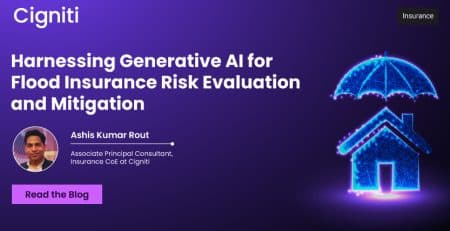Strategic Climate Risk Management: Leveraging Geospatial Property Intelligence in the Insurance Sector
|
Listen on the go!
|
Property and casualty insurers are profoundly affected by climate events like hurricanes, wildfires, and floods, which can cause extensive damage and lead to substantial claim payouts. As a result, insurers must continually reevaluate and adjust their risk models, pricing, and technology strategies to adapt to the evolving climate landscape.
The property and casualty (P&C) insurance industry is experiencing a critical digital transformation driven by integrating geospatial analytics, smart devices, and predictive analytics tools. These technologies are accelerating automation and improving underwriting decisions, leading to more efficient operations, reduced costs, and improved customer satisfaction. In this blog, we will explore how these innovations are reshaping the P&C insurance landscape.
Geospatial intelligence is rapidly emerging as an essential tool for insurance companies. This innovative approach combines geospatial data with artificial intelligence (AI) and computer vision-driven analytics to extract business insights from satellite imagery, drone footage, manned aircraft, and other sensors. AI and geospatial imagery are transforming the insurance industry, enhancing every aspect, from underwriting and risk assessment to claims processing. By combining AI with high-resolution geospatial data, insurers can obtain unprecedented insights into the specific risks of any given location.
Integrating geospatial property intelligence into the insurance workflow transfigures how insurers respond to natural disasters. This technology encourages a move from responsive techniques centered on repair, replacement, and indemnification to proactive approaches emphasizing forecast and prevention.
Exploring Geospatial Property Intelligence
Geospatial property intelligence involves collecting, analyzing, and interpreting geographic and spatial data to gain insights into property risks and values. Insurers can obtain a comprehensive view of properties and their surroundings by integrating various data sources such as satellite imagery, aerial photography, and GIS. This intelligence is crucial for assessing climate risks and making informed underwriting decisions.
Key Benefits of Geospatial Property Intelligence in Climate Risk Management
1. Optimized Risk Evaluation
Traditional risk assessment methods rely on historical data and broad geographic zones, which may not accurately reflect current and future climate risks. AI-powered geospatial data provides insurers with rapid access to critical information needed for risk assessment, policy coverage, terms, and pricing decisions. As previously mentioned, evaluating a property’s proximity to potential hazards, such as flood zones or nearby structures, is a crucial risk evaluation aspect. Insurance providers now incorporate data on various hazards, such as wildfires, earthquakes, and wind, into their risk assessments. By merging this data with property-specific details like building materials, occupancy, and other relevant factors, they can create comprehensive risk profiles for each policy
Geospatial property intelligence offers granular, real-time data, allowing insurers to evaluate risks more precisely. For example:
Flood Risk Mapping: High-resolution elevation models and historical flood data can be combined to create detailed flood risk maps. Insurers can assess the vulnerability of individual properties to flooding and adjust premiums accordingly.
Wildfire Risk Analysis: By analyzing vegetation density, weather patterns, and historical wildfire occurrences, insurers can predict which areas are at higher risk of wildfires. This enables better underwriting decisions and proactive risk mitigation strategies.
Storm Surge and Wind Risk: Geospatial data can help model the impact of storm surges and high winds on coastal properties, allowing insurers to evaluate potential damages more accurately.
2. Real-Time Monitoring and Alerts
Geospatial property intelligence enables real-time monitoring of environmental changes and emerging threats. Satellite imagery and remote sensing technologies can provide up-to-date information on evolving risks such as hurricanes, floods, and wildfires. Insurers can use this data to issue timely alerts to policyholders, helping them take preventive measures to minimize losses. For instance:
Hurricane Tracking: Real-time satellite data can track the path and intensity of hurricanes, allowing insurers to anticipate potential impacts on insured properties and prepare accordingly.
Wildfire Detection: Remote sensing technologies can detect wildfires early, enabling quick response and evacuation measures to protect lives and property.
3. Enhanced Underwriting and Pricing Strategies
Accurate risk assessment is essential for setting appropriate premiums and reserves. Geospatial property intelligence provides the detailed information needed to make informed underwriting decisions. By analyzing geographic and environmental data, insurers can better understand each property’s risk profile and price policies more accurately.
AI-based building footprints and rooftop-level geocodes provide insurers with the high-precision data essential for accurate risk assessment, eliminating the need to rely on approximate locations. This data enhances climate resilience by supporting a sophisticated understanding and proactive approach to climate risk. By leveraging AI-generated building footprints, insurers can efficiently identify climate risks and vulnerable areas, bolstering strategies to establish resilient communities. This benefits both insurance providers and the communities involved, leading to:
Risk-Based Pricing: Premiums can be tailored to reflect the specific risks associated with each property, ensuring fair pricing and reducing the likelihood of adverse selection.
Dynamic Underwriting: Geospatial data allows for continuous risk assessment, enabling insurers to update underwriting criteria and pricing models as new information becomes available.
4. Effective Loss Mitigation and Claims Management
AI-driven geospatial data is also vital for examining claims. When a policyholder makes a claim, accurately determining the impact of an event, such as a natural catastrophe, on a structure can be challenging if the insurer doesn’t have precise coordinates due to inaccurate geocodes. This location intelligence is imperative because it forms the basis for property valuations and replacement cost estimates. It also plays a crucial role in ensuring precise and reliable assessments for effective claims processing.
AI-based building footprints and rooftop geocodes provide insurers with the high-precision data necessary for effective claims assessment and validation. By accurately determining a property’s location and assessing the impact on individual structures during an event, insurers can better evaluate the effects of climate events on insured properties. This precise information enables informed decisions regarding claims, future coverage, and pricing.
Geospatial property intelligence is invaluable for both pre and post-event loss mitigation. Before an event, insurers can identify high-risk areas and work with policyholders to implement risk reduction measures. After an event, geospatial data can expedite claims processing and improve accuracy. Examples include:
Damage Assessment: High-resolution imagery and aerial surveys can quickly assess the extent of damage after a natural disaster, enabling faster and more accurate claims settlement.
Resource Allocation: Geospatial analysis helps insurers allocate resources more efficiently during disaster response, ensuring that the most affected areas receive timely assistance.
Conclusion
Strategic climate risk management through geospatial property intelligence is revolutionizing the insurance sector. By integrating advanced AI, high-resolution geospatial data, and precise analytics, insurers can better assess and manage the risks associated with climate events. This innovative approach enhances the accuracy of underwriting and claims processes and supports the development of resilient communities. Embracing these cutting-edge technologies positions insurance companies to lead in a rapidly changing environment, offering a proactive and informed response to the challenges posed by climate change.
Cigniti offers comprehensive geospatial property intelligence solutions that ensure insurance companies can thrive in the AI and digital landscape. With extensive experience in geospatial intelligence, Cigniti helps insurers understand, mitigate, and adapt their strategies to new climate risks, keeping them competitive in a changing world. Cigniti’s robust testing and digital services portfolio and unparalleled track record make it a preferred technology partner for insurance clients.
Need help? Schedule a discussion with our insurance domain experts to learn more about the opportunities the geospatial intelligence solution brings to the insurance value chain.





Leave a Reply